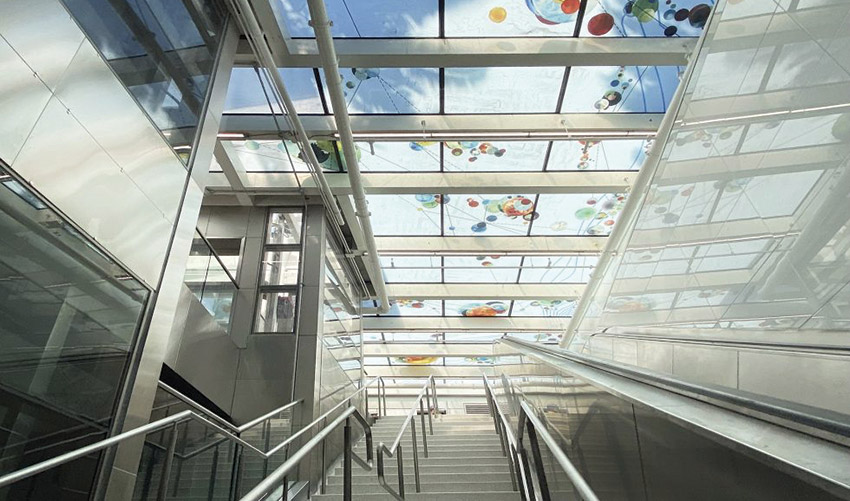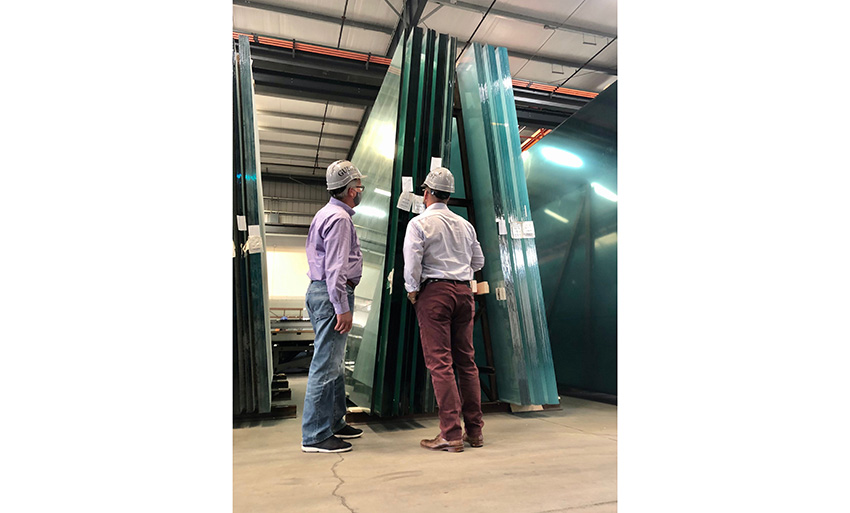Designing with Architectural Decorative Glass
Learning Objectives:
- Identify and recognize the characteristics of different types of architectural glass and some of the national safety performance standards that are applicable.
- Investigate the design potential and innovative opportunities to create building exteriors and interiors that are safe and attractive using glass technology.
- Assess the fabrication options of architectural glass to contribute to the welfare of building occupants through light and artistic applications.
- Specify different appearances, textures, and properties for architectural glass for use in new and existing commercial buildings of all types.
Credits:
This course is approved as a Structured Course
This course can be self-reported to the AANB, as per their CE Guidelines
Approved for structured learning
Approved for Core Learning
This course can be self-reported to the NLAA
Course may qualify for Learning Hours with NWTAA
Course eligible for OAA Learning Hours
This course is approved as a core course
This course can be self-reported for Learning Units to the Architectural Institute of British Columbia
Few building materials have as great an impact on aesthetics, performance, and function as glass does. Yet, not all the different types of glass and their potential for being fabricated into different architectural components are as well-known as they could be. This course provides architects and other design professionals with an overview of the full range of possibilities available from glass manufacturers and fabricators. The intent is to provide a fundamental knowledge of glass manufacturing and fabrication as used in buildings. In the process, a design palette emerges based on architectural decorative glass that can help to create buildings that excel in all areas of design and performance. The principles and concepts covered are applicable to both new and existing building designs.

Photo courtesy of Pulp Studio
Architectural decorative glass is a versatile and varied set of products that can be used to enhance design in a wide variety of applications and building types.
GLASS OVERVIEW
Architects have been using glass in innovative ways for decades, in a wide variety of ways, since glass is recognized as being infinitely changeable and functional in design spaces. As a result, manufacturers and fabricators have been pushing the limits of glass technology to reveal its exceptional properties for decoration, energy savings, and functional uses for interiors, exteriors, and public spaces. Glass can help create an energy-saving facade with opportunities for bringing daylight and views into a building. The range of visual choices means that it can be used to enhance the aesthetic appearance of the built environment. In some cases, it is also strong enough to use for safety considerations, such as guard rails or balustrades. As an interior design element, it can be fabricated with complex curves, polished edges, and stunning digital graphics that complete the visual story of a space with the potential for privacy or transparency as desired. Some glass even provides fire safety possibilities based on its makeup.

Photo courtesy of Pulp Studio
Glass is used extensively in buildings to achieve different objectives, design intents, and performance requirements.
Trends in Glass and Glazing
Design professionals currently have access to an expansive array of different glazing products with different performance and design options. Computerized design coupled with performance modeling have facilitated the refinement of architectural glass being incorporated into buildings for appearance, performance, and benefit to occupants. The outcomes have been increasingly advanced and efficient solutions.
In recent years, glass manufacturers have been asked to respond to the needs of owners and architects to provide new and higher performing glass and glazing products to suit a range of design trends. While exterior glass has needed to respond to thermal energy concerns, interior architectural glass has been sought for a full range of design applications where thermal concerns aren’t an issue. For example, architectural glass has become a primary surface to add imagery such as signage, artwork, wayfinding, and displays. Similarly, glass has become a design element unto itself with clear, patterned, opaque, or textured surfaces that are used for partitions, balustrades, feature walls, and other design elements. Of course, larger glass sizes are sometimes required for these applications, meaning that thickened glass may be necessary to maintain appropriate deflection control. Additionally, the use of bent glass has been increasing to help to deliver architectural design objectives. Current technology allows for that without compromising the structural integrity of the glass.
The Significance of Daylighting
Another significant trend is daylighting in buildings, which refers to the illumination of buildings by natural sunlight. In an era in which we have become accustomed to electric lighting, it is easy to forget that for most of the history of buildings, natural daylighting was a critical influence on architectural form. The central elements involved in daylighting strategies have been–and continue to–be windows, skylights, and other openings in the exterior. It can also include interior architectural components that allow light to pass through instead of being opaque. If translucent glass is used, the daylight can be diffused, and glare may be avoided.
People have always been naturally attracted to light. Beyond its innate lure, numerous independent scientific studies have proven that daylighting is strongly correlated with substantial improvements in human health and performance. These benefits are fundamentally attributed to the visually invigorating and productive environments provided by natural light. Daylighting can also benefit building operations. From an energy use standpoint, natural daylighting may be able to replace electric lighting used within buildings for 70-80 percent of daylight hours, correlating with lower energy costs and reduced pollution from fossil fuel-based power plants. For buildings with air conditioning, reduced electrical lighting creates less internal heat, further lowering energy costs. Daylight can have other operational benefits, too. For example, glass skylights at the Union Square BART Station in San Francisco offers a functional walking surface above ground and a safe space below that allows so much daylight that it doesn’t feel like it’s below ground.
GLASS MANUFACTURING
Recognizing the ongoing and varied need for glass in buildings, we turn our attention now to the basic processes for manufacturing different types of glass. The main ingredient of glass is SiO2 (silica sand), which is a naturally occurring material. Hence, it is not surprising to learn that glass was discovered in ancient times in settings where SiO2 was subjected to high heat, such as a lightning strike, volcano, or very hot fires as used in the bronze age. As people started to intentionally create glass, a predominant technology was to use molten SiO2 to create a sheet of glass, or other shapes (i.e., for jewelry, containers, tools, etc.). As the notion of using glass in buildings for windows developed, hot sheets of glass were moved along rollers which created imperfections in the surface of the glass. If optical clarity was needed, then the glass would need to be ground and polished to produce parallel surfaces.
During the 1950s, Sir Alastair Pilkington and Kenneth Bickerstaff of the UK's Pilkington Brothers developed technology to create optically superior glass. In their process, a continuous ribbon of molten glass flows over a molten tin bath unhindered by the influence of gravity. The top surface of the glass is then subjected to nitrogen under pressure to obtain a polished finish.

Photo courtesy of Pulp Studio
Different types of float glass are manufactured in different sizes and makeups for distribution to glass fabricators.
Virtually all mass-produced glass for use in buildings today starts with the Pilkington process. However, since that process requires considerable investment to create the facility, the furnaces to heat the material, and the equipment to move and store it, there are only a relatively small number of actual glass manufacturing companies in the world. There are, however, many companies who purchase manufactured glass in bulk and fabricate it into products for use in buildings.
The process of glass manufacturing first involves collecting the raw materials needed, the primary one (70-90 percent of glass) being silica-based sand. This is a material found in great abundance on the planet, so it is not hard to acquire. The make-up and purity, however, can vary considerably from place to place. That means impurities, such as iron or other minerals, are commonly present. Other raw materials are used to enhance the physical qualities of manufactured glass. Sodium carbonate (Na2CO3, "soda") is a common additive used to lower the glass-transition temperature. Lime (CaO, calcium oxide, generally obtained from limestone), magnesium oxide (MgO), and aluminum oxide (Al2O3) are commonly added to improve chemical durability. This is the common formulation of “soda-lime” glass, which is based on mixing the correct amounts of each material together into batches ready for glass production.
Soda–lime glass for mass production takes the mixed batch of raw materials and heats them at high temperatures in glass melting furnaces. In a melted state, the batch is homogenized and refined (i.e., removal of bubbles) and the glass is formed. To create flat sheets of glass for windows and similar building applications, the Pilkington process is used–the molten glass flows from the furnace and “floats” over a bed of molten tin, where it spreads out to form a level sheet with virtually parallel surfaces. This process is generically referred to as creating float glass. In this basic state, it can then be processed further into one of three primary types of glass, each with different characteristics and traits as discussed further below.
Annealed Float Glass
This is the most produced type of glass for buildings. It is a basic product formed from the annealing stage of the float process, whereby the molten glass is allowed to cool slowly in a controlled manner until it reaches room temperature. This process relieves any internal stresses in the glass, which if not done, would cause the glass to crack with relatively little change in temperature or slight mechanical shock. Annealed glass is used as the base product to form other types of glass. It can be made from different raw material make-ups to address visual clarity or glass color. For example, clear or “low iron” float glass can be produced by using silica sand with little or no impurities from iron or other materials. This eliminates the common “green edge” color of conventional glass caused by iron in the sand, and ultimately, the glass. Other batch configurations can produce other color variations as well, which may be desired in annealed glass. It can also be manufactured readily in different thicknesses to address different strength needs.
Heat-Strengthened Glass
This is annealed glass that is subjected to a special heat-treatment up to about 680°C (1256°F), then cooled slowly afterwards. This process makes the glass twice as strong as annealed glass. If it does break, the fragments of the broken glass may remain in the frame and are usually large and more likely to stay together. While heat strengthening increases the mechanical and thermal strength of annealed glass, it is NOT recognized as a “safety glass” by typical building codes. Therefore, it is not to be used in balustrades or similar structural applications because of its limited strength compared to code recognized alternatives.
Tempered Glass
Tempered glass is at least four times stronger than annealed glass, making it more suitable for code-compliant glass facades, sliding doors, building entrances, bath and shower enclosures, balustrades, and other uses requiring superior strength and safety properties. When broken, tempered glass shatters into many small, regular fragments rather than long shards, which reduces the potential for major injuries. Tempered glass is annealed glass that is heated to about 700°C by conduction, convection, and radiation. Unlike the heat strengthened glass, the cooling process for tempered glass is accelerated by a uniform and simultaneous blast of air on both surfaces. The different cooling rates between the surface and the inside of the glass produce different physical properties, resulting in compressive stresses in the surface balanced by tensile stresses in the body of the glass.

















